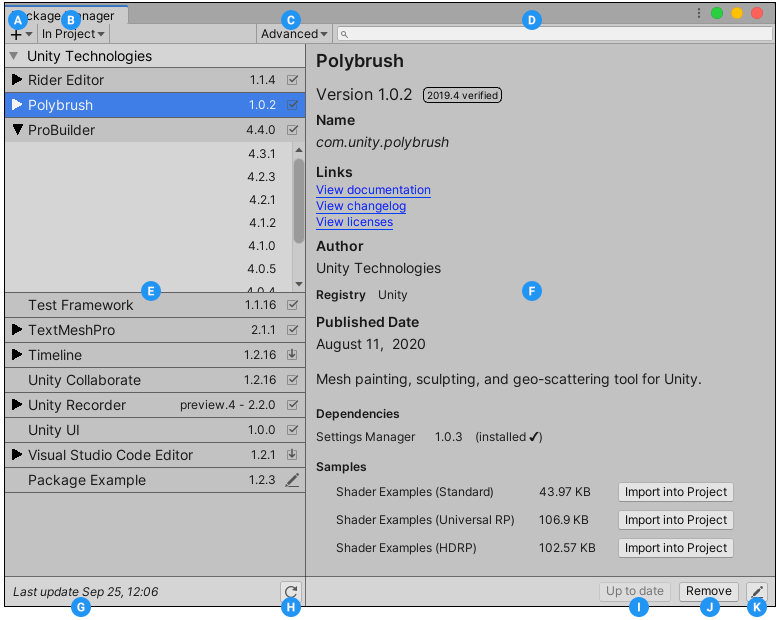Package Manager window
Use the Unity Package Manager (in Unity’s top menu: Window > Package Manager) to view which packages are available for installation or already installed in your project. In addition, you can use this window to see which versions are available, and install, remove, disable, or update packages for each project.

The Package Manager window displays:
(A) The add  button, which you can click to install a package directly into your project by entering a git URL or a local path.
button, which you can click to install a package directly into your project by entering a git URL or a local path.
(B) The Packages drop-down menu, which you can use to change what appears in the list (context):
(C) The Advanced drop-down menu, which you can click to display preview packages in addition to those that have been verified to work with Unity, show the dependency
See in Glossary list in the details for each package, or reset your project’s packages to default.
(D) The search box, which you can use to look for packages by name.
(E) The packages list view, which displays all packages that match the filter and search parameters you specify.
(F) The package-specific detail view, which displays information specific to the package selected in the list.
(G) The status bar, which displays messages about the package load status and any errors or warnings.
(H) The reload  button, which you can click to force Package Manager to reload your packages.
button, which you can click to force Package Manager to reload your packages.
(I) Buttons to install or update a package (or the Up to date message if the selected version is already installed.)
(J) Buttons to remove or disable the package.
(K) The manifest  button, which you can click to display the package.json manifest file in the InspectorA Unity window that displays information about the currently selected GameObject, asset or project settings, allowing you to inspect and edit the values. More info
button, which you can click to display the package.json manifest file in the InspectorA Unity window that displays information about the currently selected GameObject, asset or project settings, allowing you to inspect and edit the values. More info
See in Glossary view. If this is a local or an embedded package, you can edit it directly in the Inspector; otherwise, it is read-only.
Advanced actions
The Advanced drop-down menu allows you to perform these actions:
| Drop-down menu item | Action results |
|---|---|
| Reset Packages to defaults | Select this item to return to Unity Package Manager default settings. Warning: This removes all customization from your project manifest file. Only use this a last resort when you can’t figure out what is wrong with your project manifest file. |
| Show dependencies | Display each package’s dependencies in the details view. |
| Show preview packages | Display preview packagesA preview package is in development and not yet ready for production. A package in preview might be at any stage of development, from the initial stages to near completion. See in Glossary in the packages list when browsing the Unity Registry. Note: Preview packages are not verified to work with Unity and might be unstable. They are not supported in production environments. |
| Advanced Project SettingsA broad collection of settings which allow you to configure how Physics, Audio, Networking, Graphics, Input and many other areas of your project behave. More info See in Glossary |
Select this item to open the Package Manager project settings, where you can add, edit and remove scoped registries in your project. |
Status bar
The Package Manager displays messages in the status bar at the bottom left of the Package Manager window.
There are typically four status messages that you might see:
-
The first time you open the Package Manager window in a new project, the Loading packages message appears briefly:

Loading packages message This message also appears when you click the reload
 button.
button. -
Most of the time the status bar displays the date and time of when the Package Manager window last refreshed its information:

Last update message -
However, if the Package Manager detects a problem, such as a missing network connection, the Package Manager displays an error in the status bar:

Network error message -
If your network connection is working, but you are not signed into your Unity account, the Package Manager doesn’t display any Asset StoreA growing library of free and commercial assets created by Unity and members of the community. Offers a wide variety of assets, from textures, models and animations to whole project examples, tutorials and Editor extensions. More info
See in Glossary packages. When you try to use the My Assets scope, the Package Manager displays an error in the status bar:
Logged out of Unity account In the list view, click the Sign in button to sign into your Unity account through the Unity Hub.
For information on how to resolve these errors and more, see Error messages.